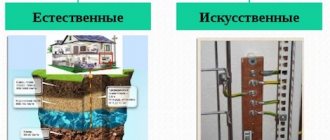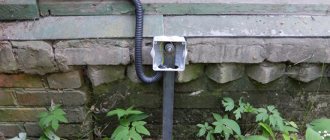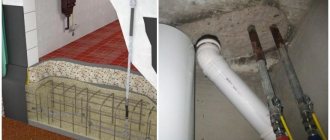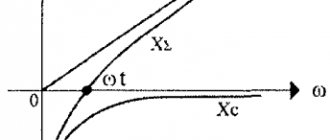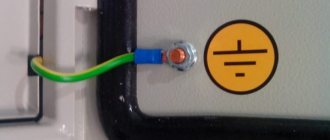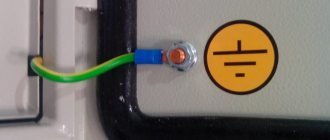1.7.109
The following can be used as natural grounding electrodes:
1) metal and reinforced concrete structures of buildings and structures that are in contact with the ground, including reinforced concrete foundations of buildings and structures that have protective waterproofing coatings in non-aggressive, slightly aggressive and moderately aggressive environments;
2) metal water pipes laid in the ground;
3) casing pipes of boreholes;
4) metal sheet piles of hydraulic structures, water conduits, embedded parts of valves, etc.;
5) rail tracks of main non-electrified roads and railways and access roads in the presence of a deliberate arrangement of jumpers between the rails;
6) other metal structures of structures located in the ground;
7) metal shells of armored cables laid in the ground. Cable sheaths can serve as the only grounding conductors when there are at least two cables. Aluminum cable sheaths are not allowed to be used as grounding conductors.
2.5.131
When passing overhead lines of 110 kV and higher in areas with clayey, loamy, sandy loam and similar soils with a resistivity of 1000 Ohm m, reinforcement of reinforced concrete foundations, supports and stepsons should be used as natural grounding conductors without additional installation or in combination with laying artificial grounding conductors. In soils with higher resistivity, the natural conductivity of reinforced concrete foundations should not be taken into account, and the required resistance value of the grounding device should be ensured only by the use of artificial ground electrodes.
The required resistance of grounding devices of 35 kV overhead line supports must be ensured by the use of artificial grounding conductors, and the natural conductivity of foundations, underground parts of supports and stepsons (attachments) should not be taken into account in calculations.
Grounding on a pile foundation: pros and cons
Electrical installation rules do not prohibit the organization of a grounding loop on piles, but with several reservations.
An important condition for using foundation piles in a grounding loop is the absence of a coating based on polyurethane resins on the metal rods. As a rule, they are used everywhere to treat piles to protect them from spontaneous destruction under the influence of the external environment. But, at the same time, polyurethane resins have low electrical conductivity. A circuit built on piles treated with such substances will not work. You can increase the wear resistance of foundation pins without compromising conductivity by using special conductive paints. There is an opinion that classic paints and varnishes are also suitable for these purposes. But actually it is not. Cheap paints from the mass market will crumble when driving piles into the ground.
Summarizing the experience of specialists, we can highlight a number of advantages in arranging a frame for grounding on piles:
- Saving. Creating a down conductor based on a pile foundation significantly reduces the cost of construction work;
- Grounding quality. The combination of foundation and contour ensures increased dispersion, and therefore improves grounding performance;
- Reliability of supports. The construction of the contour on piles has a beneficial effect on the strength of the foundation itself. The fact is that in case of combination, experts recommend choosing pins with a slight thickening, which increases the stability of the foundation, and therefore the structure as a whole.
In addition to the advantages, arranging grounding on screw piles in a frame house also has its disadvantages. Experts identify two significant disadvantages that should be taken into account when installing a grounding loop on pile supports:
- Nearby objects. It is not recommended to install a grounding loop on piles in houses located near cell towers, railway facilities or power plants. The fact is that these objects are sources of significant leakage of electricity into the ground, which negatively affects the service life of pile supports. Additional electrification in the form of a “thrown” circuit will only increase the wear of the supports;
- Welds. If you plan to combine a pile foundation and a ground loop, it is recommended to reduce the number of welding seams as much as possible. The fact is that in combination with a current load, welding seams become “weak points” of the structure. They are primarily subject to corrosion damage.
Main types
According to the PUE (Electrical Installation Rules), there is a TN grounding system (including groups TN-C, TN-S, TN-CS), TT and IT. The Latin letters in the designation have the following meaning:
- T – power source connected to ground;
- S – opening is carried out by different conductors;
- N – neutral;
- C – open with one conductor;
- I – insulated current-carrying part.
Knowing what each letter of the designation means, you can determine the structure and operating principle of the grounding device to which the electrical equipment is connected.
TN system
The most common protective grounding system. Its main feature is the presence of a “tightly” grounded neutral of the supply network. In other words, the zero output of the supply network is directly connected to the ground loop.
TN-C - this grounding system was widely used in the construction of old residential buildings, but nowadays it is not used in the construction of houses, as it is outdated and does not meet all safety standards. This type of grounding of electrical appliances is used in three-phase networks with a four-core cable and single-phase networks with cables having two cores. The main disadvantage of this type is the absence of a protective grounding conductor in the cables.
TN-S is a system often used to connect buildings to the electrical network. Has the highest degree of protection among all grounding systems. The neutral and working conductors, in this system, are laid separately from each other, while the protective conductor is connected to all current-carrying parts of the equipment being stripped. The disadvantages of this type of grounding include the need to lay an additional cable.
TN-CS - in this system, the protective conductor core is connected to the neutral working core. According to electrical safety regulations, the TN-CS system requires the installation of additional grounding.
TT system
This system is widely used to ensure electrical safety of supply substations and installations that have a separate grounding device. Often used to protect separate premises (garages, stalls, hangars and other structures).
IT system
The power source in this system is isolated by an air gap or connected by an element with high resistance, which can significantly reduce the leakage current. The IT type grounding system is most often used in medical institutions and laboratories to ensure the correct operation of high-precision, surge-sensitive devices.
Selection of piles for grounding arrangement
When building houses with grounding on stilts, it is recommended to use galvanized pins. The building materials market offers options for both cold and hot galvanizing. Let's consider both options in terms of suitability for arranging a ground loop:
- Cold galvanized piles. This processing method has sufficient conductive properties to create a ground loop. But, in terms of wear resistance, it will require additional anti-corrosion treatment with a conductive coating. Experts note that if the wear-resistant properties of the pins are not enhanced with cold processing, the destruction of the structure will begin already at the stage of driving them into the ground;
- Hot galvanized piles. This method involves literally “imprinting” a protective layer onto the external and internal cavities of the pin under the influence of high temperatures. Piles treated in this way have high wear resistance. The conductive properties, however, do not deteriorate. The only disadvantage of hot-dip galvanized piles is the high cost of the final product.
To ground a house on screw piles, experts recommend using pins processed using hot-dip galvanization technology. This will ensure not only the standard level of grounding, but also increase the wear resistance of the structure. In addition, it is recommended to choose this type of piles if you plan to build a multi-storey household.
2.5.129
The following must be grounded on the overhead line:
1) supports with lightning protection cable or other lightning protection devices;
2) reinforced concrete and metal supports of 3-35 kV overhead lines;
3) supports on which power or instrument transformers, disconnectors, fuses and other devices are installed;
4) metal and reinforced concrete supports of 110-500 kV overhead lines without cables and other lightning protection devices, if this is necessary under the conditions for ensuring the operation of relay protection and automation.
Wooden poles and wooden poles with metal traverses of overhead lines without lightning protection cables or other lightning protection devices are not grounded.
The resistance of the grounding devices of the supports given in clause 1, with their height up to 50 m, should be no more than those given in Table 2.5.19; with a support height of more than 50 m - 2 times lower compared to those given in Table 2.5.19. On double-circuit and multi-circuit overhead line supports, regardless of the line voltage and height of the supports, it is recommended to reduce the resistance of grounding devices by 2 times compared to those given in Table 2.5.19.
Table 2.5.19 The highest resistance of grounding devices of overhead line supports
| Specific equivalent soil resistance, Ohm m | Maximum resistance of the grounding device, Ohm |
| Up to 100 | 10 |
| More than 100 to 500 | 15 |
| More than 500 to 1000 | 20 |
| More than 1000 to 5000 | 30 |
| More than 5000 | 6·10 |
It is allowed to exceed the grounding resistance of some supports compared to the standardized values if there are supports with reduced values of grounding resistance, and the expected number of lightning outages does not exceed the values obtained when the requirements of Table 2.5.19 are met for all overhead line supports.
For mountain overhead line supports located at altitudes of more than 700 m above sea level, the grounding resistance values indicated in Table 2.5.19 can be increased by 2 times. The resistance of the grounding devices of the supports specified in paragraph 2 for 3-20 kV overhead lines passing in populated areas, as well as all 35 kV overhead lines should be no more than those given in Table 2.5.19: for 3-20 kV overhead lines in uninhabited areas in in soils with resistivity up to 100 Ohm m - no more than 30 Ohm, and in soils with resistivity above 100 Ohm m - no more than 0.3 Ohm.
The resistance of the grounding devices of the supports of overhead lines of 110 kV and higher, specified in clause 3, should be no more than those given in Table 2.5.19, and for overhead lines of 3-35 kV should not exceed 30 Ohms.
The resistances of the grounding devices of the supports specified in clause 4 are determined when designing the overhead line.
For overhead lines protected by cables, the resistance of grounding devices made according to lightning protection conditions must be ensured when the cable is disconnected, and under other conditions - when the cable is not disconnected.
The resistance of grounding devices of overhead line supports must be provided and measured at industrial frequency currents during the period of their highest values in the summer. It is allowed to take measurements in other periods with the results adjusted by introducing a seasonal coefficient, however, measurements should not be made during a period when the value of the resistance of grounding devices is significantly affected by soil freezing.
The place where the grounding device is connected to the reinforced concrete support must be accessible for measurements.
Classification of grounding systems
The following grounding systems are distinguished:
- TN system (which in turn is divided into subtypes TN-C, TN-S, TN-CS)
- TT system
- IT system
The letters in the names of the systems are taken from the Latin alphabet and are deciphered as follows: T – (from terre) earth N – (from neuter) neutral C – (from combine) combine S – (from separate) divide I – (from isole) isolated According to the letters in the names grounding systems, you can learn how the power source is designed and grounded, as well as the principle of grounding the consumer.
TN system
This is the most famous and popular grounding system. Its main difference is the presence of a “solidly grounded” neutral of the power source. Those. The neutral wire of the supply substation is directly connected to the ground. TN-C is a subtype of the grounding system, which is characterized by a combined grounding and neutral neutral conductor. Those. they go in one wire from the supply transformer to the consumer. The absence of a separate PE (protective neutral) conductor in this system is clearly a disadvantage. The TN-C system was widely used in Soviet buildings and is unsuitable for modern new buildings because it lacks the ability to equalize potentials in the bathroom. TN-S is a system in which the protective conductor of the potential equalization system and the working neutral conductors run in separate wires from the power source to the electrical installation. This system is only becoming widely used when connecting buildings to power supply. Is the safest. The disadvantages include its high cost, because... installation of an additional conductor is required. TN-CS is a system in which the neutral protective conductor and the neutral working conductor are connected by a combined wire, and are separated at the entrance to the distribution board. According to the requirements of the Electrical Installation Rules, this system requires additional grounding.
TT system
This is a system in which the supply substation and the consumer's electrical installation have different grounding conductors independent of each other. The scope of application of the TT system is mobile objects with electrical installations of consumers. These include mobile containers, stalls, trailers, etc. In most cases, modular-pin grounding is used for the consumer in the TT system.
IT system
A system in which the power supply is separated from the ground through an air space or connected through a large resistance, i.e. isolated. The neutral in this system is connected to ground through a large resistance. The IT system is used in laboratories and medical institutions where high-precision and sensitive equipment operates.
Distance from ground electrode to...?
06.07.15
One of the most popular questions when organizing grounding is the question of the distance to objects that must be observed when installing a ground electrode. Let's look at this issue using the following regulatory documents:
- Rules for the construction of electrical installations (PUE);
- Instructions for organizing protective grounding and potential equalization in electrical installations (I 1.03-08);
- Guidelines for protecting secondary circuits of power plants and substations from impulse noise (RD 34.20.116-93).
1. Distance from the ground electrode to the foundation of the building
The answer to this question can be found in paragraph 1.7.94 of the PUE, which reads:
“...laying in the ground at a depth of 1 m and at a distance of 1 m from the foundation of the building or from the perimeter of the territory occupied by the equipment, a grounding conductor connected to the potential equalization system of this building or this territory, and at the entrances and at the entrances to the building - laying conductors on at a distance of 1 and 2 m from the ground electrode at a depth of 1 and 1.5 m, respectively, and the connection of these conductors with the ground electrode…”
2. Distance from grounding to power cables and pipes
Excerpt from Instruction 1.03-08:
The laying of grounding conductors parallel to cables or pipelines should be carried out at a distance of at least 0.3 meters, and at intersections - at least 0.1 meters. This paragraph normalizes the distance to the grounding device when the distance to the lightning rod/down conductor is more than 10 meters (horizontally).
3. Another document - RD 34.20.116-93 sets its requirements for the distance from various objects to the ground electrode with connected lightning protection:
Cable routes with control, measurement and signaling circuits must be laid at a distance of at least 10 meters clear from the base of foundations (racks) with arresters and lightning rods. In cramped conditions, it is possible to reduce this distance to 5 m, but at the same time, an additional longitudinal grounding conductor with a length of at least 15 meters must be laid between the foundation (rack) and the cables at a distance of 0.5 meters from the cable route. This longitudinal grounding conductor must be located symmetrically relative to the foundation (rack) and connected to the grounding device at the ends and at the points of intersection with other horizontal grounding conductors.
Design and calculate grounding and lightning protection correctly!
For designers:
- Distance from grounding to gas pipeline
- Free webinars for designers
- Grounding - what is it and how to do it?
[News block code for embedding on your website] [RSS feed for subscribing to news]
Do you want to receive selected news about lightning protection and grounding once every 3-4 weeks? Register and automatically receive an email newsletter with a selection.
All news is published in our groups in instant messengers and on social networks. [News channel on Telegram]
See also:
Lightning protection of a social rehabilitation center for minors
Lightning protection of a townhouse in the Leningrad region
Copper plating of ground pins: is 100 microns thick enough?
Lightning protection of the college of culture in the Komi Republic
Wind load on lightning rods
Lightning protection and grounding of a concrete plant in permafrost
Lightning protection of a block gas control point in the Moscow region
Video recording of the webinar “When is isolated lightning protection useful?”
Why do airplanes need grounding?
The partner appreciated the high quality of ZANDZ products
Webinar "Online calculation of lightning protection of an explosives warehouse"
How does lightning protection work for wind generators?
General requirements
2.2.5. In networks of 6-35 kV industrial enterprises, for transmission in one direction of power more than 15-20 MVA at a voltage of 6 kV, more than 25-35 MVA at a voltage of 10 kV and more than 35 MVA at a voltage of 35 kV should be used, As a rule, flexible or rigid conductors are predominantly located in front of lines made of a large number of cables laid in parallel.
Open laying of current conductors should be used in all cases where it is possible according to the conditions of the general plan of the power supply facility and the environment.
2.2.6. In places where the air contains chemically active substances that have a destructive effect on current-carrying parts, supporting structures and insulators, current conductors must have an appropriate design or other measures must be taken to protect them from these effects.
2.2.7. The calculation and selection of conductors, insulators, fittings, structures and devices of current conductors should be made both according to normal operating conditions (correspondence to operating voltage and current) and according to operating conditions during short circuits (see Chapter 1.4).
2.2.8. Live parts must be marked and colored in accordance with the requirements of Chapter. 1.1.
2.2.9. Current-carrying parts of conductors should, as a rule, be made of aluminum, steel-aluminum and steel wires, pipes and profile-section buses.
2.2.10. To ground current-carrying parts of conductors, stationary grounding blades or portable grounding connections must be provided in accordance with the requirements of 4.2.25 (see also 2.2.30, clause 3).
2.2.11. Mechanical loads on conductors, as well as design ambient temperatures should be determined in accordance with the requirements given in 4.2.46-4.2.49.
2.2.12. The layout and design of conductors must provide for the possibility of convenient and safe installation and repair work.
2.2.13. Conductors above 1 kV in the open air must be protected from lightning overvoltages in accordance with the requirements of 4.2.167 and 4.2.168.
2.2.14. In AC busbars with a symmetrical load at a current of 1 kA or more, it is recommended, and at a current of 1.6 kA or more, measures should be taken to reduce electricity losses in busbar supports, fittings and structures from exposure to a magnetic field.
At currents of 2.5 kA or more, measures must also be taken to reduce and equalize the inductive reactance (for example, the arrangement of strips in packages on the sides of a square, the use of paired phases, profile buses, round and square hollow pipes, transposition). For long flexible conductors, it is also recommended to use intra-phase transpositions, the number of which should be determined by calculation depending on the length of the conductor.
With asymmetrical loads, the current value at which it is necessary to provide measures to reduce electricity losses from the influence of a magnetic field must be determined by calculation in each individual case.
2.2.15. In cases where temperature changes, vibration of transformers, uneven settlement of the building, etc. can lead to dangerous mechanical stresses in conductors, insulators or other elements of conductors, measures should be taken to eliminate these stresses (compensators or similar devices). On rigid current conductors, expansion joints should also be installed at intersections with temperature and sedimentation joints of buildings and structures.
2.2.16. Permanent connections of current conductors are recommended to be made by welding. To connect branches with flexible current conductors, the use of pressed clamps is allowed.
Connections of conductors made of different materials must be made in such a way that corrosion of the contact surfaces is prevented.
2.2.17. The selection of the cross-section of conductors above 1 kV for long-term permissible current in normal and post-emergency modes should be made taking into account the expected increase in loads, but no more than 25-30% higher than the calculated ones.
2.2.18. For current conductors made using bare wires, long-term permissible currents should be determined according to Chapter. 1.3 using a coefficient of 0.8 in the absence of intraphase transposition of wires, 0.98 in the presence of intraphase transposition of wires.
Issues covered in the PUE
Regulation of the operating procedure for various types of protective systems can be presented in the form of a certain set of requirements relating to the arrangement of individual structures.
According to them, the functional readiness of grounding loops, which include a whole set of structural elements, must be confirmed by the following technical data:
- Description of the design and composition of protective devices used in existing electrical installations;
- Formulas for calculating their sizes, as well as the resistance standards of grounding devices (GD);
- Tables with correction factors that allow you to introduce corrections for the quality and condition of the soil at the location of the contour (taking into account the material of individual elements);
- The procedure for organizing and conducting control tests available for grounding systems.
On a note. The presence of documented data on the performance characteristics and reliability of the functioning of the grounding loop of a private house, for example, will eliminate the possibility of electric shock to animals and residents.
When installing it, you are required to act in strict accordance with the PUE, as well as comply with all requirements regarding the operation of this protective device.
Types of material (profiles)
According to the requirements of the PUE, which contain instructions on what the resistance of current flow in the ground should be, in most cases this indicator is set at a level of no more than 4 ohms. To obtain this value, you usually have to make a lot of effort to adhere to the same technology requirements.
First of all, this concerns the materials used in assembling the grounding loop, selected based on the following conditions:
- When choosing pins, preference should be given to ferrous metal blanks;
- The most commonly used rod is a standard size of 16-20 mm or a corner with parameters 50x50x5 mm and a metal thickness of about 5 mm;
- It is not allowed to use reinforcement as circuit elements, since it has a hardened surface that affects the normal flow of current;
- For these purposes, it is pure rod that is suitable, and not its reinforcement substitute.
Note! For areas with dry summers, thick-walled metal pipes are best suited, the lower end of which is flattened into a cone, and then several holes are drilled in this part of the pipe. According to the provisions of the PUE, before placing them in the ground, holes of the required length are first drilled, since driving them manually is quite problematic
In the case of a particularly dry summer and a sharp deterioration in the parameters of the ground electrode, a concentrated saline solution is poured into the hollow parts of the pipes, which makes it possible to obtain the resistance that should be in accordance with the requirements of the PUE. The length of pipe blanks is selected within 2.5-3 meters, which is quite enough for most Russian regions
According to the provisions of the PUE, before placing them in the ground, holes of the required length are first drilled, since driving them in manually is quite problematic. In the case of a particularly dry summer and a sharp deterioration in the parameters of the ground electrode, a concentrated saline solution is poured into the hollow parts of the pipes, which makes it possible to obtain the resistance that should be in accordance with the requirements of the PUE. The length of pipe blanks is selected within 2.5-3 meters, which is quite enough for most Russian regions.
This type of profile blanks has special requirements regarding the order of their placement in the soil and consists of the following:
- Firstly, the pipe elements of the protective circuit must be placed at a depth exceeding the soil freezing level by at least 80-100 cm;
- Secondly, in particularly dry areas, approximately a third of the length of the ground electrode should reach wet soil layers;
- Thirdly, when fulfilling the second condition, one should focus on the peculiarities of the location of the so-called “groundwater” in a given region. If they are located at a significant depth, according to the rule formulated in the provisions of the PUE, it will be necessary to prepare longer pipe sections.
The type and profile of the pin blanks used in the construction of the grounding switch can be found in the figure below.
Acceptable pin profiles
In practice, in most regions of Russia, a steel corner and a strip of the same metal are usually used. In order to obtain more accurate parameters of the grounding elements used, geological survey data will be required. If this information is available, it will be possible to involve specialists in calculating the parameters of the ground electrode.
Stages of installing a ground loop on screw piles
According to the Rules for the Construction of Electrical Installations, which regulate the process of creating and commissioning pantographs, the arrangement of grounding loops on house piles takes place in several fundamental stages:
- Choice of terrain. Before driving screw piles and starting to create a contour, it is necessary to determine the level of soil freezing. The depth of the pile trenches directly depends on this. For the middle zone of the European part of the country, pins up to 57 millimeters in diameter are suitable. What thickness has optimal frost-resistant and conductive properties. The site for the grounding loop must be “removed” at least a meter from the planned foundation.
- Marking. It is recommended to install piles in strict accordance with the rules of an equilateral triangle. For convenience and to minimize errors, you can carry out preliminary markings and mark the places for the piles with pegs, between which you need to dig a trench at least 50 centimeters deep. Another trench will be required to connect the household and the circuit. It is recommended to dig it from the nearest corner of the “down conductor triangle”.
- Assembly of the structure. The markings made at the preparatory stage will help to quickly assemble the ground loop. To reduce the cost of the process, you can secure the pins and metal tape by welding. But experts recommend using a bolt. This will increase the wear resistance of the structure and protect it from corrosion. If it was not possible to avoid welding, after the structure has cooled, it is recommended to treat it with an anti-corrosion compound.
- Connection between contour and structure. The final stage of creating a current drainage system for a private house is connecting the circuit and the distribution board using a conductor. The connector, usually copper, is laid in a pre-dug trench. The system is secured with a grounding bus using a nut and bolt, previously welded to the grounding loop.
Organizing grounding on a foundation pile is a process that requires “surgical” precision. Specialists will help you arrange the circuit as soon as possible. Many years of experience will allow you to quickly decide on a work plan based on the characteristics of the area and the layout of the building. In addition, proper arrangement of the grounding loop will allow significant savings on fines that the homeowner faces if violations are detected during an inspection by supervisory authorities.
